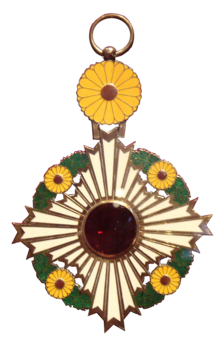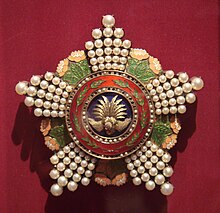Orders, decorations, and medals of Japan
This article may be expanded with text translated from the corresponding article in Japanese. (January 2020) Click [show] for important translation instructions.
|



The Japanese honours system originated in the 1870s, shortly after the Meiji Restoration, and was modeled on European honour systems. The first order, the Imperial Order of Meiji was established in 1875, and was later renamed as the Order of the Rising Sun.[1]
Current Orders[]
- Supreme Order of the Chrysanthemum – Established in 1876 as the premier order of Japan; originally in one class (Grand Cordon) and expanded to two classes (Collar; Grand Cordon) in 1888.[1]
- Collar – The highest possible honour that may be conferred. The Collar is only worn by the reigning Emperor, and is normally only awarded to foreign monarchs as a courtesy. Before 1947, the Collar was also conferred upon extremely eminent Cabinet ministers, senior members of the Imperial family and certain senior military officers of the rank of Marshal. It may be posthumously awarded to extremely distinguished Prime Ministers of Japan; the last such award was to Yasuhiro Nakasone in 2019.
- Grand Cordon – Typically conferred upon royals of the Imperial House of Japan, foreign royalty who are not reigning monarchs, certain foreign non-royal Heads of State, and select Japanese Prime Ministers. Until 1947, the Grand Cordon was often conferred upon eminent military officers of the rank of Marshal. Often conferred posthumously.
- Order of the Paulownia Flowers – Established in 1888 as a Special Grand Cordon to the Order of the Rising Sun, but made a separate order in 2003. Ordinarily the highest regularly awarded honor, it is conferred in a single class (Grand Cordon); typically awarded to Japanese prime ministers, senior statesmen, select foreign heads of government, distinguished cabinet ministers and jurists. Until 1947, it was also awarded to distinguished military officers of the rank of General or higher, or its equivalents.[2]
- Order of the Rising Sun – Established in 1875 as Japan's first order.[3] Awarded in nine classes prior to 2003: The Grand Cordon of the order is typically awarded to foreign heads of government, chairpersons of prominent international organizations and leading politicians, business leaders and diplomats. The second class is typically conferred upon prominent academics, politicians and military officers. The third through sixth classes are ordinarily conferred upon individuals who have made significant contributions to Japan in varying degrees. The 7th and 8th classes of the Order were abolished in 2003, and the Special First Class of the Order was renamed the Order of the Paulownia Flowers.
- 1st Class: Grand Cordon
- 2nd Class: Gold and Silver Star
- 3rd Class: Gold Rays with Neck Ribbon
- 4th Class: Gold Rays with Rosette
- 5th Class: Gold and Silver Rays
- 6th Class: Silver Rays
- Order of the Sacred Treasure – Established in 1888 as the Imperial Order of Meiji in eight classes. Since the revision of the decoration system in 2003, the Order of the Sacred Treasure has been awarded to civil servants for their long-term contributions. They include government and local officials, military personnel, scholars of national universities, and school teachers. For example, from 2014, the former Chief of Staff, Joint Staff is awarded Grand Cordon of the Order of the Sacred Treasure at the age of 70. The 7th and 8th classes were abolished in 2003.
- 1st Class: Grand Cordon
- 2nd Class: Gold and Silver Star
- 3rd Class: Gold Rays with Neck Ribbon
- 4th Class: Gold Rays with Rosette
- 5th Class: Gold and Silver Rays
- 6th Class: Silver Rays
- Order of Culture – Established in 1937 as a single-class order of merit to honor those who have made outstanding contributions to Japanese culture. Japanese Nobel Laureates were awarded the Order of Culture.
- Order of the Precious Crown – Established in 1888 in five classes; expanded to seven classes in 1896. The 7th class of the order was abolished sometime after the Second World War. Initially awarded to select foreigners who were not eligible for a higher honor, but subsequently only awarded to women. From 2003, with the opening of the Order of the Rising Sun to Japanese women, the order has only been awarded to foreign females.
- 1st Class: Grand Cordon
- 2nd Class: Peony Class
- 3rd Class: Butterfly Class
- 4th Class: Wisteria Class
- 5th Class: Apricot Class
- 6th Class: Ripple Class
- Medals of Honor – Established in 1881 to honor individuals who have made distinguished achievements in their respective fields of society.
- Medal with Red Ribbon-to individuals who have risked their own lives to save others
- Medal with Green Ribbon-to morally remarkable individuals who have actively taken part in serving society
- Medal with Yellow Ribbon-to individuals who, through their diligence and perseverance, became public role models
- Medal with Purple Ribbon-to individuals who have contributed to academic and artistic developments, improvements and accomplishments
- Medal with Blue Ribbon-to individuals who have made prosperous efforts in the areas of public welfare and education
- Medal with Dark Blue Ribbon-to individuals who have made exceptionally generous financial contributions for the good of the public
Criteria for awards (Japanese nationals)[]
- Grand Cordon of the Order of the Chrysanthemum: The highest conferred honor; for exceptional merit.
- Grand Cordon of the Order of the Paulownia Flowers: For an exemplary and distinguished level of merit.
- Grand Cordon of the Order of the Rising Sun: For highly distinguished national and/or public service.
- Grand Cordon of the Order of the Sacred Treasure: For long and distinguished national and/or public service.
- Second through Sixth Classes of the Order of the Rising Sun: For those cited for outstanding achievement.
- Second through Sixth Classes of the Order of the Sacred Treasure: For long and distinguished public service.
- Order of Culture: For particularly significant achievements in regards to the furthering of cultural development.[4]
Statistics[]
As of November 2021, a total of 150,632 orders have been conferred upon living Japanese nationals since 2003, when the honours system was overhauled. These include 19 awards of the Order of the Paulownia Flowers, 34,593 awards of the Order of the Rising Sun and 116,020 awards of the Order of the Sacred Treasure.[5][note 1] Of those decorations, the Order of the Sacred Treasure (77.02% of the total, all classes) is the most commonly conferred decoration, followed by the Order of the Rising Sun (22.97% of the total, all classes). The Order of the Paulownia Flowers is conferred the most rarely, at only 0.13% of the total number of decorations awarded since 2003.[5]
Per class of decoration, excluding the Order of the Chrysanthemum, the breakdown of decorations awarded by level since 2003 is as follows:
- 354 awards at the level of Grand Cordon (0.24% of total)
- 1,744 at the level of Gold and Silver Star (1.16% of total)
- 11,917 at the level of Gold Rays with Neck Ribbon (7.91% of total)
- 33,461 at the level of Gold Rays with Rosette (22.21% of total)
- 58,466 at the level of Gold and Silver Rays (38.81% of total)
- 44,690 at the level of Silver Rays (29.67% of total)[5]
Since 2003, the most commonly conferred decorations by class and level in the top five categories as of 2021 have been:[5]
- Silver Rays of the Order of the Sacred Treasure (40,564 awards; 26.93% of total)
- Gold and Silver Rays of the Order of the Sacred Treasure (38,268 awards; 25.40% of total)
- Gold Rays with Rosette of the Order of the Sacred Treasure (25,692 awards; 17.06% of total)
- Gold and Silver Rays of the Order of the Rising Sun (20,198 awards; 13.41% of total)
- Gold Rays with Neck Ribbon of the Order of the Sacred Treasure (10,104 awards; 6.71% of total)
For the year 2021, 8,172 decorations were conferred in the following numbers upon living Japanese:[5]
- Order of the Paulownia Flowers (0 awards; 0.000% of total)
- Grand Cordon: 0
- Order of the Rising Sun (1,912 awards; 23.40% of total)
- Grand Cordon: 4
- Gold and Silver Star: 19
- Gold Rays with Neck Ribbon: 89
- Gold Rays with Rosette: 370
- Gold and Silver Rays: 1,056
- Silver Rays: 374
- Order of the Sacred Treasure (6,260 awards; 76.60% of total)
- Grand Cordon: 4
- Gold and Silver Star: 67
- Gold Rays with Neck Ribbon: 611
- Gold Rays with Rosette: 1,328
- Gold and Silver Rays: 2,040
- Silver Rays: 2,188
Past system[]
2003 revision[]
In the system before the 2003 revision, titles consisted of two parts, the class number () and the decoration. For example:
- 勲一等旭日桐花大綬章 (literally: 1st Class, Grand Cordon of the Order of the Rising Sun, Paulownia Flowers)[6]
- 勲一等旭日大綬章 (literally: 1st Class, Grand Cordon of the Order of the Rising Sun)[6]
- 勲二等旭日重光章 (literally: 2nd Class, The Order of the Rising Sun, Gold and Silver Star)[6]
although their official English translations did not have these class numbers.[6] The 2003 revision removed the class part from the titles, thus:
- 桐花大綬章 (Grand Cordon of the Order of the Paulownia Flowers)[7]
- 旭日大綬章 (Grand Cordon of the Order of the Rising Sun)[7]
- 旭日重光章 (The Order of the Rising Sun, Gold and Silver Star)[7]
Notes[]
- ^ The highest Japanese decoration, the Order of the Chrysanthemum, has not been conferred upon a living Japanese national who is not a member of the Imperial Family since 1997, when former Prime Minister Yasuhiro Nakasone was decorated with the Grand Cordon of the Order.
References[]
- ^ a b "Supreme Orders of the Chrysanthemum".
- ^ Grand Cordon of the Order of the Paulownia Flowers
- ^ Orders of the Rising Sun
- ^ "勲章の種類及び授与対象" (in Japanese).
- ^ a b c d e Cabinet Office Decorations and Medals Bureau. "春秋叙勲受章者数(勲章別、年別、春秋別)(平成15年~)" (PDF) (in Japanese). Retrieved 2016-03-12.
- ^ a b c d 勲章及び褒章の英訳名 [English translations of Orders and Honours]. Cabinet Office, Government of Japan (in Japanese). Archived from the original on 2003-02-19. (pre-2003 codes)
- ^ a b c 勲章及び褒章の英訳名 [English translations of Orders and Honours]. Cabinet Office, Government of Japan (in Japanese). Archived from the original on 2003-12-11. (post-2003 codes)
External links[]
| Wikimedia Commons has media related to Orders, decorations and medals of Japan. |
- Orders, decorations, and medals of Japan


